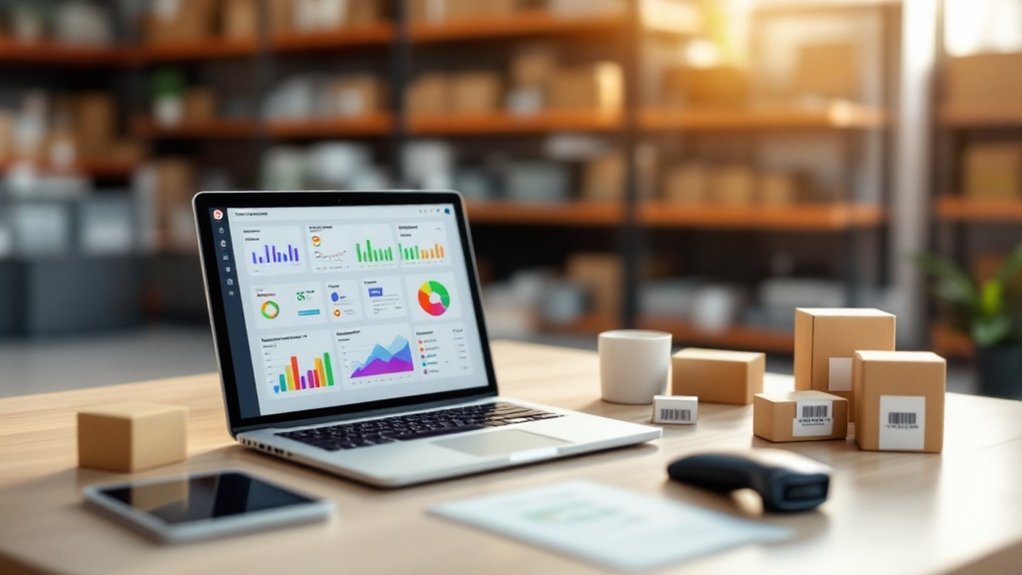Small businesses benefit greatly from integrated accounting and inventory software solutions that automate critical tasks and reduce manual errors. Popular options like Zoho Inventory, Sortly, and QuickBooks Commerce offer essential features including real-time tracking, cloud-based tools, and automated billing processes. When selecting software, businesses should evaluate features like scalability, user-friendliness, and integration capabilities with existing systems. Understanding the key considerations helps companies make informed decisions that support sustainable growth and operational efficiency.
Quick Overview
- QuickBooks Commerce and Lightspeed Inventory provide seamless accounting integration, making them ideal solutions for small businesses tracking finances and inventory.
- Cloud-based software solutions offer real-time inventory tracking across multiple locations while ensuring data accessibility from anywhere.
- Zoho Inventory provides cost-effective options with e-commerce integration and a free starter plan suitable for small business budgets.
- Automated billing and barcode scanning features reduce manual errors and save valuable staff time in daily operations.
- Select scalable software that accommodates business growth and integrates smoothly with existing systems to avoid costly future upgrades.
Why Your Small Business Needs Integrated Inventory Management

Nearly every small business owner faces the challenge of managing inventory effectively, often struggling with manual systems that lead to costly mistakes and inefficiencies. Integrated inventory management software offers a practical solution to these common challenges.
The benefits of implementing an integrated system are substantial. Real-time tracking guarantees accurate stock levels, preventing costly stockouts and overstock situations. The automation of routine tasks reduces manual errors while freeing up staff time for more valuable activities. Barcode scanning technology significantly reduces data entry errors and speeds up inventory processes. Modern solutions like real-time analytics help businesses optimize stock levels across multiple locations.
Additionally, seamless integration with accounting and e-commerce platforms streamlines operations across all sales channels.
For growing businesses, these systems provide essential data for strategic decision-making. With detailed inventory insights, owners can make informed choices about ordering, pricing, and marketing strategies, ultimately leading to improved customer satisfaction and stronger cash flow management.
Key Features to Look for in Accounting and Inventory Software
When selecting accounting and inventory software for a small business, choosing a solution with the right combination of features can make the difference between streamlined operations and daily frustrations.
Essential features should include robust financial reporting tools for tracking business performance, real-time inventory management across multiple locations, and automated billing processes. Advanced software functionality enables businesses to reduce manual errors through automated data entry and validation.
Modern solutions like cloud-based tools offer powerful expense tracking and cash flow management capabilities that help streamline financial operations.
Look for software that offers seamless integration with existing business platforms, particularly ecommerce systems and accounting tools. The solution should also provide customizable dashboards for monitoring key metrics and analyzing sales trends.
Security and scalability are equally important considerations. Choose software that implements strong data protection measures, offers regular automatic backups, and can grow alongside your business.
User-friendly interfaces and reliable customer support guarantee smooth implementation and daily operations.
Top Software Solutions for Small Business Inventory Control

Several leading software solutions stand out in today's market for small business inventory control, each offering unique advantages for different business needs.
Zoho Inventory provides extensive features with e-commerce integration and a free starter plan, making it accessible for new businesses.
Sortly excels with its user-friendly interface and visual tracking capabilities, while Cin7 offers robust demand forecasting for growing companies.
For budget-conscious businesses, both Veeqo and Square Inventory offer free versions with essential features. Modern inventory solutions help prevent overstocking and shortages while optimizing capital allocation.
Companies requiring strong accounting integration should consider QuickBooks Commerce or Lightspeed Inventory, which sync seamlessly with popular accounting platforms. With real-time insights, QuickBooks helps businesses track expenses and monitor cash flow efficiently.
The trend toward AI-driven insights and customizable dashboards is evident in newer versions of these solutions, helping businesses make data-driven decisions while maintaining efficient stock levels.
Real Benefits of Combining Accounting and Inventory Systems
The integration of accounting and inventory systems represents a transformative approach for small businesses seeking enhanced operational efficiency.
By combining these essential functions, businesses can streamline operations, reduce errors, and make data-driven decisions with greater confidence. Real-time data access and automated processes create a foundation for sustainable growth while ensuring compliance with financial regulations. Solutions like TallyPrime offer lot-wise tracking capabilities to help businesses maintain precise control over their inventory. Modern solutions like multi-entity management features enable businesses to efficiently handle multiple company accounts within a single system.
- Saves precious time by eliminating double data entry, allowing business owners to focus on strategic growth initiatives
- Enhances accuracy through automated tracking, reducing costly inventory discrepancies and accounting errors
- Provides crystal-clear visibility into cash flow and stock levels, enabling smarter purchasing decisions
- Boosts customer satisfaction by maintaining ideal inventory levels and ensuring timely order fulfillment
Getting Started With Inventory Management Integration

Successful integration of inventory management systems begins with careful planning and strategic implementation of essential tools and processes. The first step involves selecting cloud-based software that seamlessly connects with existing accounting and point-of-sale systems while offering room for growth. Implementing data analytics tools helps businesses make data-driven decisions for optimizing inventory levels. Modern asset tracking software provides enhanced visibility and reduces manual errors in inventory management.
Key components for effective integration include:
- Installing barcode or RFID systems for accurate tracking
- Setting up automated reordering triggers
- Implementing real-time reporting capabilities
- Establishing a centralized database
- Training staff on new procedures
Small businesses should prioritize solutions that offer multi-channel support and thorough warehouse management features.
Regular system updates and ongoing technical support guarantee smooth operations, while customization options allow the software to adapt to specific business needs. This foundation sets the stage for efficient inventory control across all sales channels.
Making the Right Software Choice for Your Business Needs
Selecting appropriate accounting and inventory software represents a critical decision point for small business owners seeking to streamline their operations. Success depends on carefully evaluating current needs while considering future growth potential.
Business owners must assess their specific requirements, from basic inventory tracking to complex multi-channel sales integration. Automatic replenishment capabilities ensure optimal stock levels are maintained without manual intervention. QuickBooks Online offers robust cash flow monitoring and expense tracking features essential for modern business management.
- Find software that grows with your business, preventing costly upgrades later
- Choose solutions that smoothly connect with existing systems to avoid frustrating workflow disruptions
- Look for user-friendly interfaces that will help your team adapt quickly and confidently
- Select providers offering reliable support to guarantee peace of mind during critical business moments
When comparing options, prioritize features that align with daily operations while maintaining a reasonable budget.
Free trials and demos provide valuable hands-on experience before making a final commitment. Consider both immediate functionality and long-term scalability to make an informed decision.
Frequently Asked Questions
How Long Does It Typically Take to Train Staff on Inventory Software?
Staff training on inventory software typically takes 2-4 weeks for basic proficiency, though this varies based on several factors.
Experienced users might grasp the basics within a week, while new users may need up to six weeks.
The complexity of the software, frequency of training sessions, and availability of support materials all impact learning time.
Most organizations find that combining hands-on practice with guided instruction yields the best results.
Can Inventory Software Track Items Across Multiple Warehouse Locations Simultaneously?
While some business owners still dream of managing inventory with stone tablets and carrier pigeons, modern inventory software absolutely can track items across multiple warehouse locations simultaneously.
These systems provide real-time visibility into stock levels, enable seamless transfers between locations, and support automated barcode scanning for accuracy.
Through integrated mobile tracking and cloud-based updates, businesses can monitor their entire inventory network with precision, eliminating the headaches of manual tracking methods.
What Happens to Inventory Data if the Software System Crashes?
When a software system crashes, the impact on inventory data depends on several factors. Modern systems typically have automatic backup features that preserve data up to the last save point. However, unsaved changes may be lost.
Recovery options include:
- Restoring from recent backups
- Using redundant data storage systems
- Accessing cloud-based backup copies
To minimize data loss risks, businesses should:
- Implement regular backup schedules
- Use uninterruptible power supplies
- Keep software updated
- Maintain offline backups
Are There Industry-Specific Inventory Management Solutions for Specialized Businesses?
Yes, specialized businesses have access to industry-specific inventory management solutions.
The hospitality sector (HoReCa) uses systems with recipe management and waste tracking features.
Manufacturing businesses benefit from tools like MRPeasy, which includes production planning and material requirements tracking.
Retail and e-commerce companies often choose platforms like Square, offering real-time tracking and e-commerce integration.
These specialized solutions address unique industry challenges while maintaining core inventory management functionality.
How Often Should Businesses Perform Physical Inventory Counts With Automated Systems?
Even with automated systems, businesses need strategic physical inventory counts.
Most companies should conduct full physical counts annually, supplemented by targeted cycle counts throughout the year. High-value or fast-moving items typically require monthly checks, while slower-moving inventory may need quarterly verification.
The frequency depends on factors like inventory turnover, value, and historical accuracy rates. Automated systems allow for more efficient spot-checks and reduce the burden of thorough counts.
Conclusion
Choosing the right accounting and inventory software can make or break a small business's efficiency. While the initial setup requires careful consideration and investment, the long-term benefits of an integrated system are worth their weight in gold. By following this guide's recommendations and evaluating options based on specific business needs, owners can confidently select a solution that streamlines operations and promotes sustainable growth.








